Assessing Climatic Drivers of Spring Mean and Annual Maximum Flows in Western Canadian River Basins
Abstract
1. Introduction
2. Study Area and Data Sets
3. Application Methods
3.1. Multiple Linear Regression (MLR)
3.2. Predictors’ Relative Importance
3.3. Future Projection of Annual Peak and Spring Flows
4. Results and Discussion
4.1. Spearman’s Rank Correlation
4.2. MLR Model Performances
4.3. Predictors’ Relative Importance
4.4. Projected Changes in Hydroclimatic Variables
4.5. Projected Changes in AMF and MAMJflow
5. Summary and Conclusions
Supplementary Materials
Author Contributions
Funding
Institutional Review Board Statement
Informed Consent Statement
Data Availability Statement
Acknowledgments
Conflicts of Interest
References
- Berghuijs, W.R.; Woods, R.A.; Hrachowitz, M. A precipitation shift from snow towards rain leads to a decrease in streamflow. Nat. Clim. Chang. 2014, 4, 583–586. [Google Scholar] [CrossRef]
- Burn, D.H. Climatic influences on streamflow timing in the headwaters of the Mackenzie River Basin. J. Hydrol. 2008, 352, 225–238. [Google Scholar] [CrossRef]
- Dudley, R.W.; Hodgkins, G.A.; McHale, M.R.; Kolian, M.J.; Renard, B. Trends in snowmelt-related streamflow timing in the conterminous United States. J. Hydrol. 2017, 547, 208–221. [Google Scholar] [CrossRef]
- Sandink, D. Urban flooding and ground-related homes in Canada: An overview. J. Flood Risk Manag. 2016, 9, 208–223. [Google Scholar] [CrossRef]
- Dibike, Y.; Prowse, T.; Bonsal, B.; O’Neil, H. Implications of future climate on water availability in the western Canadian river basins. Int. J. Climatol. 2017, 37, 3247–3263. [Google Scholar] [CrossRef]
- Bawden, A.J.; Burn, D.H.; Prowse, T.D. Recent changes in patterns of western Canadian river flow and association with climatic drivers. Hydrol. Res. 2015, 46, 551–565. [Google Scholar] [CrossRef]
- Bonsal, B.; Shrestha, R.R.; Dibike, Y.; Peters, D.L.; Spence, C.; Mudryk, L.; Yang, D. Western Canadian Freshwater Availability: Current and Future Vulnerabilities. Environ. Rev. 2020, 28, 528–545. [Google Scholar] [CrossRef]
- Kang, D.H.; Gao, H.; Shi, X.; ul Islam, S.; Déry, S.J. Impacts of a rapidly declining mountain snowpack on streamflow timing in Canada’s Fraser River basin. Sci. Rep. 2016, 6, 1–8. [Google Scholar] [CrossRef] [PubMed]
- Barnett, T.P.; Adam, J.C.; Lettenmaier, D.P. Potential impacts of a warming climate on water availability in snow-dominated regions. Nature 2005, 438, 303–309. [Google Scholar] [CrossRef]
- Buttle, J.M.; Allen, D.M.; Caissie, D.; Davison, B.; Hayashi, M.; Peters, D.L.; Pomeroy, J.W.; Simonovic, S.; St-Hilaire, A.; Whitfield, P.H. Flood processes in Canada: Regional and special aspects. Can. Water Resour. J. 2016, 41, 7–30. [Google Scholar] [CrossRef]
- Erler, A.R.; Peltier, W.R. Projected changes in precipitation extremes for western Canada based on high-resolution regional climate simulations. J. Clim. 2016, 29, 8841–8863. [Google Scholar] [CrossRef]
- Shrestha, R.R.; Cannon, A.J.; Schnorbus, M.A.; Alford, H. Climatic controls on future hydrologic changes in a subarctic river basin in Canada. J. Hydrometeorol. 2019, 20, 1757–1778. [Google Scholar] [CrossRef]
- Najafi, M.R.; Zwiers, F.; Gillett, N. Attribution of the Observed Spring Snowpack Decline in British Columbia to Anthropogenic Climate Change. J. Clim. 2017, 30, 4113–4130. [Google Scholar] [CrossRef]
- Dibike, Y.; Eum, H.I.; Prowse, T. Modelling the Athabasca watershed snow response to a changing climate. J. Hydrol. Reg. Stud. 2018, 15, 134–148. [Google Scholar] [CrossRef]
- Shrestha, R.R.; Bonsal, B.R.; Bonnyman, J.M.; Cannon, A.J.; Najafi, M.R. Heterogeneous snowpack response and snow drought occurrence across river basins of northwestern North America under 1.0 °C to 4.0 °C global warming. Clim. Chang. 2021, 164, 1–21. [Google Scholar] [CrossRef]
- Stewart, I.T. Changes in snowpack and snowmelt runoff for key mountain regions. Hydrol. Process. 2009, 23, 78–94. [Google Scholar] [CrossRef]
- Rood, S.B.; Pan, J.; Gill, K.M.; Franks, C.G.; Samuelson, G.M.; Shepherd, A. Declining summer flows of Rocky Mountain rivers: Changing seasonal hydrology and probable impacts on floodplain forests. J. Hydrol. 2008, 349, 397–410. [Google Scholar] [CrossRef]
- Milner, A.M.; Khamis, K.; Battin, T.J.; Brittain, J.E.; Barrand, N.E.; Füreder, L.; Cauvy-Fraunié, S.; Gíslason, G.M.; Jacobsen, D.; Hannah, D.M.; et al. Glacier shrinkage driving global changes in downstream systems. Proc. Natl. Acad. Sci. USA 2017, 114, 9770–9778. [Google Scholar] [CrossRef] [PubMed]
- Cunderlik, J.M.; Ouarda, T.B. Trends in the timing and magnitude of floods in Canada. J. Hydrol. 2009, 375, 471–480. [Google Scholar] [CrossRef]
- Dibike, Y.; Eum, H.I.; Coulibaly, P.; Hartmann, J. Projected Changes in the Frequency of Peak Flows along the Athabasca River: Sensitivity of Results to Statistical Methods of Analysis. Climate 2019, 7, 88. [Google Scholar] [CrossRef]
- Curry, C.L.; Zwiers, F.W. Examining controls on peak annual streamflow and floods in the Fraser River Basin of British Columbia. Hydrol. Earth Syst. Sci. 2018, 22, 2285–2309. [Google Scholar] [CrossRef]
- Tsakiri, K.; Marsellos, A.; Kapetanakis, S. Artificial neural network and multiple linear regression for flood prediction in Mohawk River, New York. Water 2018, 10, 1158. [Google Scholar] [CrossRef]
- Moradi, A.M.; Dariane, A.B.; Yang, G.; Block, P. Long-range reservoir inflow forecasts using large-scale climate predictors. Int. J. Climatol. 2020, 40, 5429–5450. [Google Scholar] [CrossRef]
- Shrestha, R.R.; Pesklevits, J.; Yang, D.; Peters, D.L.; Dibike, Y.B. Climatic Controls on Mean and Extreme Streamflow Changes Across the Permafrost Region of Canada. Water 2021, 13, 626. [Google Scholar] [CrossRef]
- Environment and Climate Change Canada. National Hydrometric Network Basin Polygons. Available online: https://open.canada.ca/data/en/dataset/0c121878-ac23-46f5-95df-eb9960753375 (accessed on 15 May 2019).
- Neteler, M.; Bowman, M.H.; Landa, M.; Metz, M. GRASS GIS: A multi-purpose open source GIS. Environ. Model Softw. 2012, 31, 124–130. [Google Scholar] [CrossRef]
- Shrestha, R.R.; Schnorbus, M.A.; Werner, A.T.; Berland, A.J. Modelling spatial and temporal variability of hydrologic impacts of climate change in the Fraser River basin, British Columbia, Canada. Hydrol. Process. 2012, 26, 1840–1860. [Google Scholar] [CrossRef]
- Werner, A.T.; Schnorbus, M.A.; Shrestha, R.R.; Cannon, A.J.; Zwiers, F.W.; Dayon, G.; Anslow, F. A long-term, temporally consistent, gridded daily meteorological dataset for northwestern North America. Sci. Data 2019, 6, 1–16. [Google Scholar] [CrossRef]
- Gelaro, R.; McCarty, W.; Suárez, M.J.; Todling, R.; Molod, A.; Takacs, L.; Randles, C.A.; Darmenov, A.; Bosilovich, M.G.; Reichle, R.; et al. The modern-era retrospective analysis for research and applications, version 2 (MERRA-2). J. Clim. 2017, 30, 5419–5454. [Google Scholar] [CrossRef]
- Reichle, R.H.; Draper, C.S.; Liu, Q.; Girotto, M.; Mahanama, S.P.; Koster, R.D.; De Lannoy, G.J. Assessment of MERRA-2 land surface hydrology estimates. J. Clim. 2017, 30, 2937–2960. [Google Scholar] [CrossRef]
- Gaál, L.; Szolgay, J.; Kohnová, S.; Hlavčová, K.; Parajka, J.; Viglione, A.; Merz, R.; Blöschl, G. Dependence between flood peaks and volumes: A case study on climate and hydrological controls. Hydrol. Sci. J. 2015, 60, 968–984. [Google Scholar] [CrossRef]
- Hastie, T.; Tibshirani, R.; Friedman, J. The Elements of Statistical Learning: Data Mining, Inference, and Prediction, 2nd ed.; Springer Science & Business Media: Berlin, Germany, 2009; pp. 57–58. [Google Scholar]
- Laio, F.; Di Baldassarre, G.; Montanari, A. Model selection techniques for the frequency analysis of hydrological extremes. Water Resour. Res. 2009, 45, W07416. [Google Scholar] [CrossRef]
- James, G.; Witten, D.; Hastie, T.; Tibshirani, R. An Introduction to Statistical Learning with Applications in R; Springer: New York, NY, USA, 2013; pp. 59–126. [Google Scholar]
- Schoups, G.; Van de Giesen, N.C.; Savenije, H.H.G. Model complexity control for hydrologic prediction. Water Resour. Res. 2008, 44, W00B03. [Google Scholar] [CrossRef]
- Grömping, U. Relative importance for linear regression in R: The package relaimpo. J. Stat. Softw. 2006, 17, 1–27. [Google Scholar] [CrossRef]
- Scinocca, J.F.; Kharin, V.V.; Jiao, Y.; Qian, M.W.; Lazare, M.; Solheim, L.; Flato, G.M.; Biner, S.; Desgagne, M.; Dugas, B. Coordinated global and regional climate modeling. J. Clim. 2016, 29, 17–35. [Google Scholar] [CrossRef]
- Shrestha, R.R.; Schnorbus, M.A.; Werner, A.T.; Zwiers, F.W. Evaluating hydroclimatic change signals from statistically and dynamically downscaled GCMs and hydrologic models. J. Hydrometeorol. 2014, 15, 844–860. [Google Scholar] [CrossRef]
- Sharma, A.R.; Déry, S.J. Linking atmospheric rivers to annual and extreme river runoff in British Columbia and southeastern Alaska. J. Hydrometeorol. 2020, 21, 2457–2472. [Google Scholar] [CrossRef]
- Rupp, D.E.; Chegwidden, O.S.; Nijssen, B.; Clark, M.P. Changing river network synchrony modulates projected increases in high flows. Water Resour. Res. 2021. [Google Scholar] [CrossRef]
- Eum, H.I.; Dibike, Y.; Prowse, T. Climate-induced alteration of hydrologic indicators in the Athabasca River Basin, Alberta, Canada. J. Hydrol. 2017, 544, 327–342. [Google Scholar] [CrossRef]
- Schnorbus, M.; Werner, A.; Bennett, K. Impacts of climate change in three hydrologic regimes in British Columbia, Canada. Hydrol. Process. 2014, 28, 1170–1189. [Google Scholar] [CrossRef]
- Werner, A.T.; Schnorbus, M.A.; Shrestha, R.R.; Eckstrand, H.D. Spatial and Temporal Change in the Hydro-Climatology of the Canadian Portion of the Columbia River Basin under Multiple Emissions Scenarios. Atmos. Ocean 2013, 51, 357–379. [Google Scholar] [CrossRef]
- Shook, K.; Pomeroy, J.; van der Kamp, G. The transformation of frequency distributions of winter precipitation to spring streamflow probabilities in cold regions; case studies from the Canadian Prairies. J. Hydrol. 2015, 521, 395–409. [Google Scholar] [CrossRef]
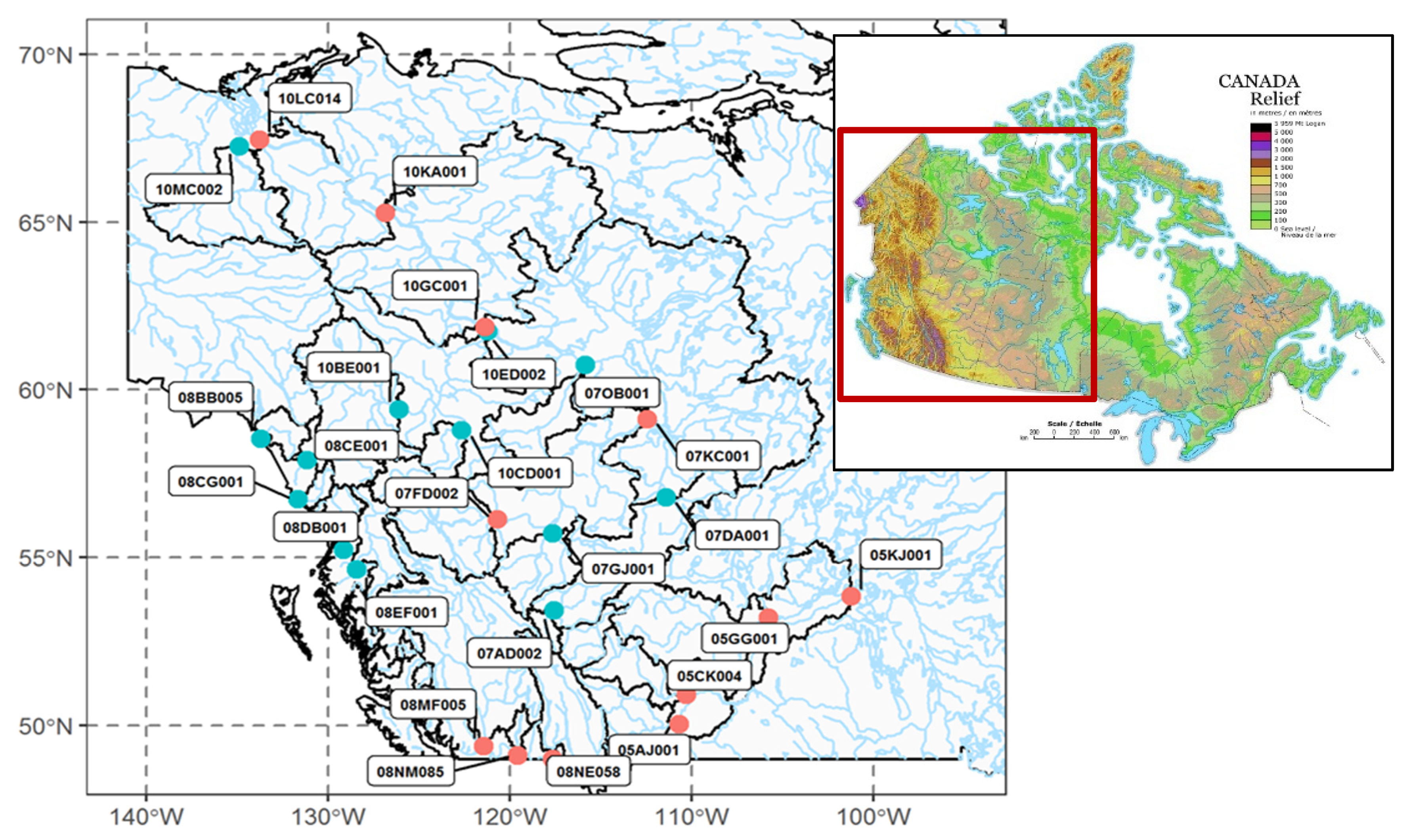
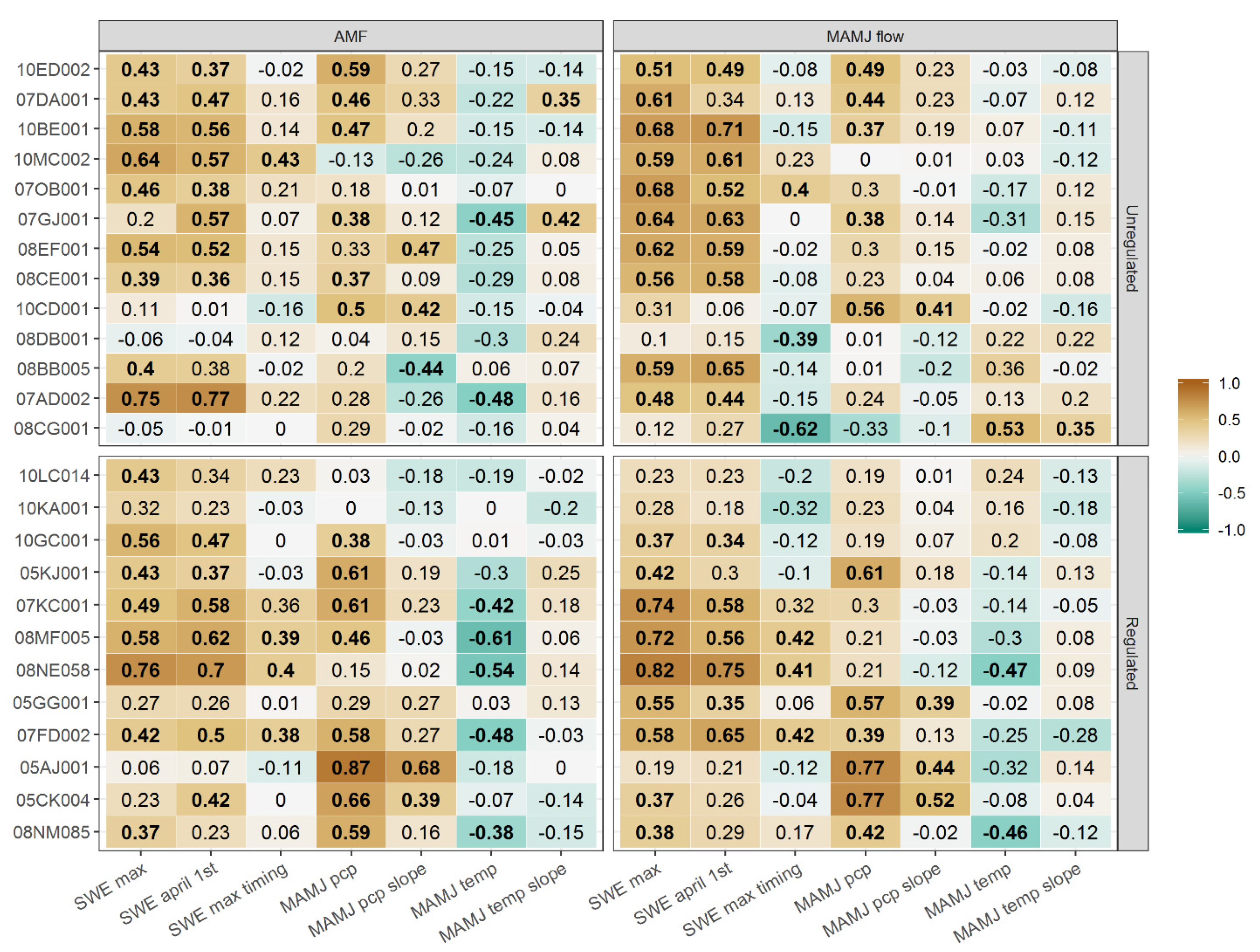
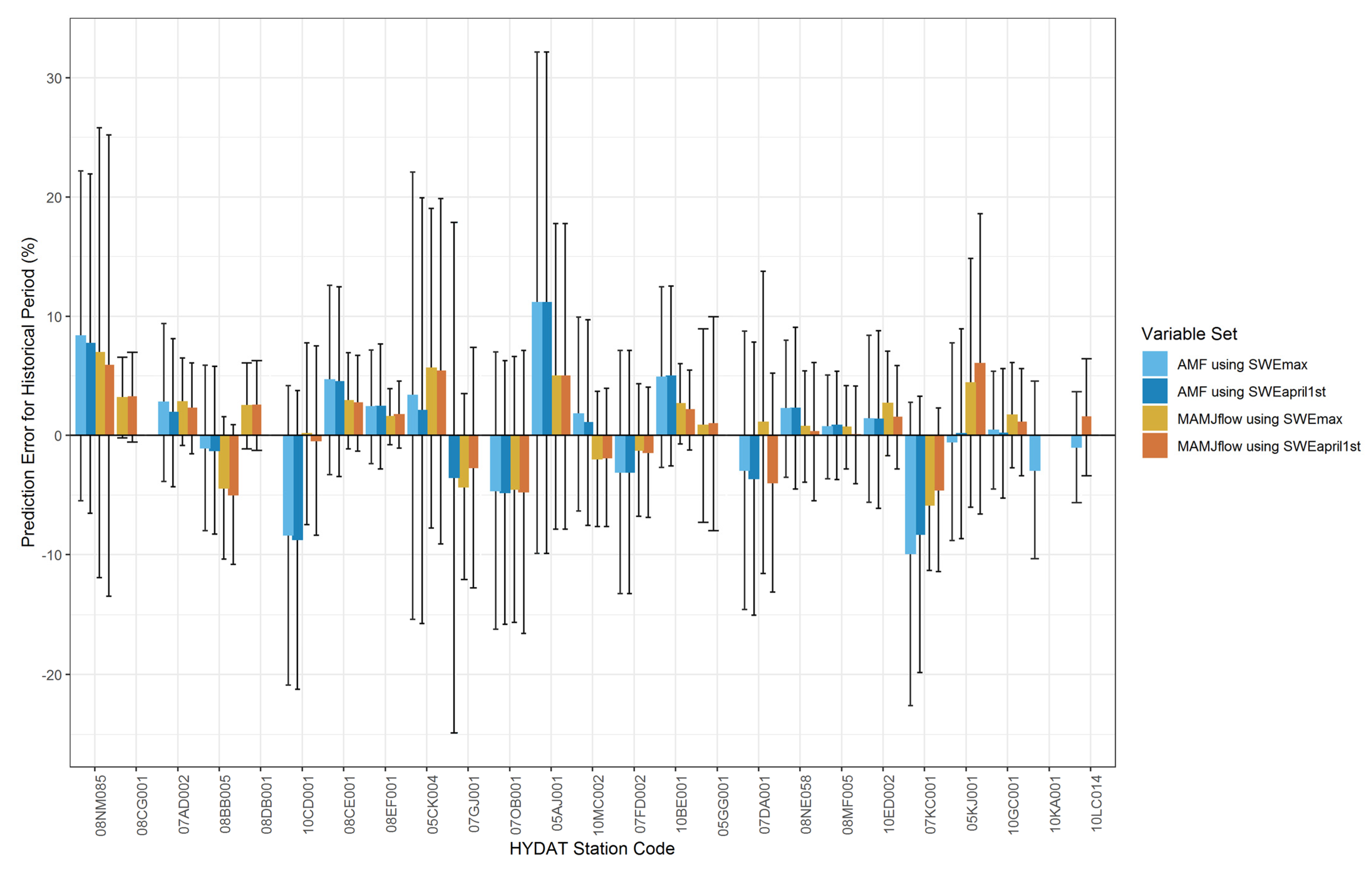
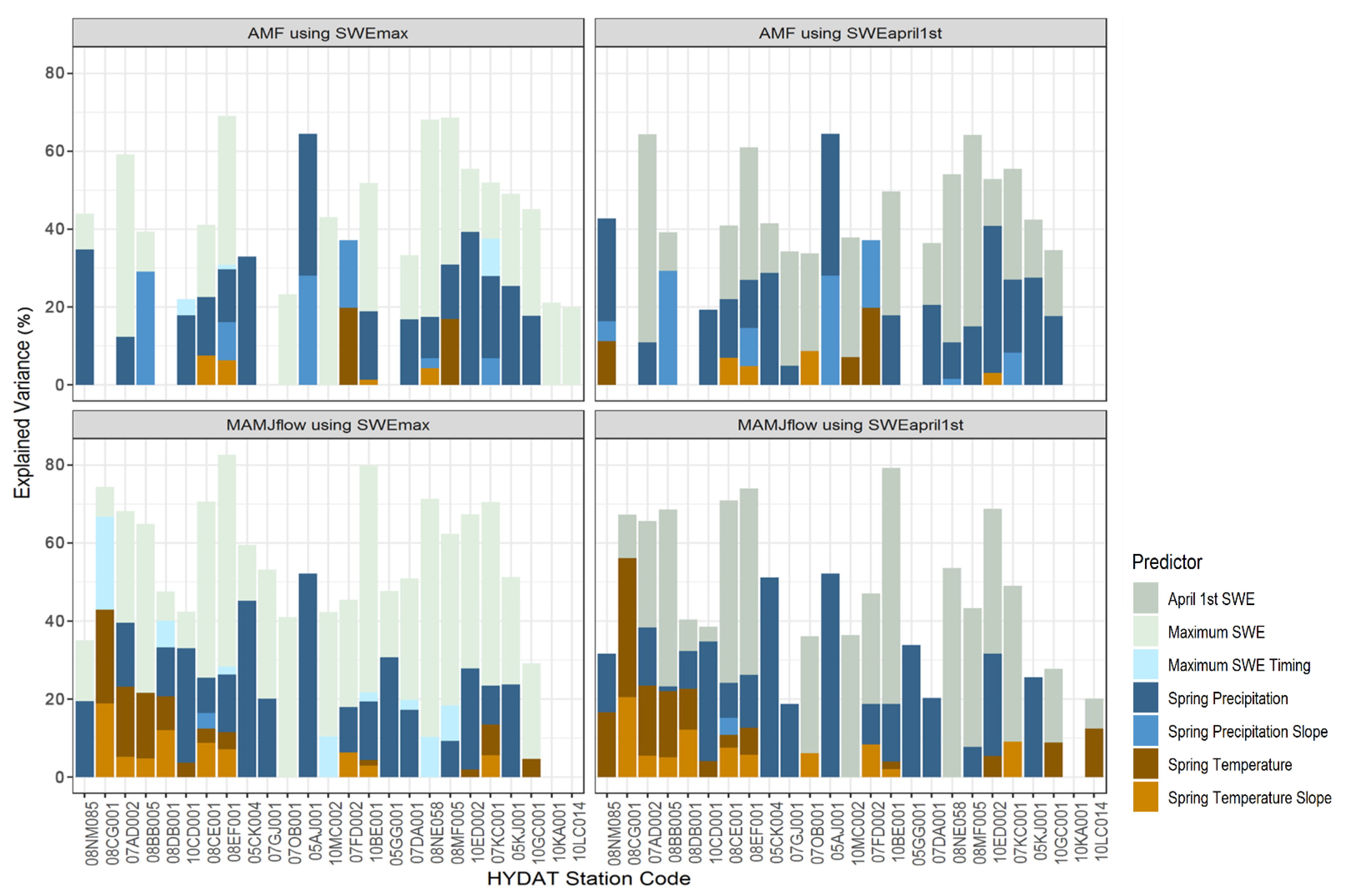
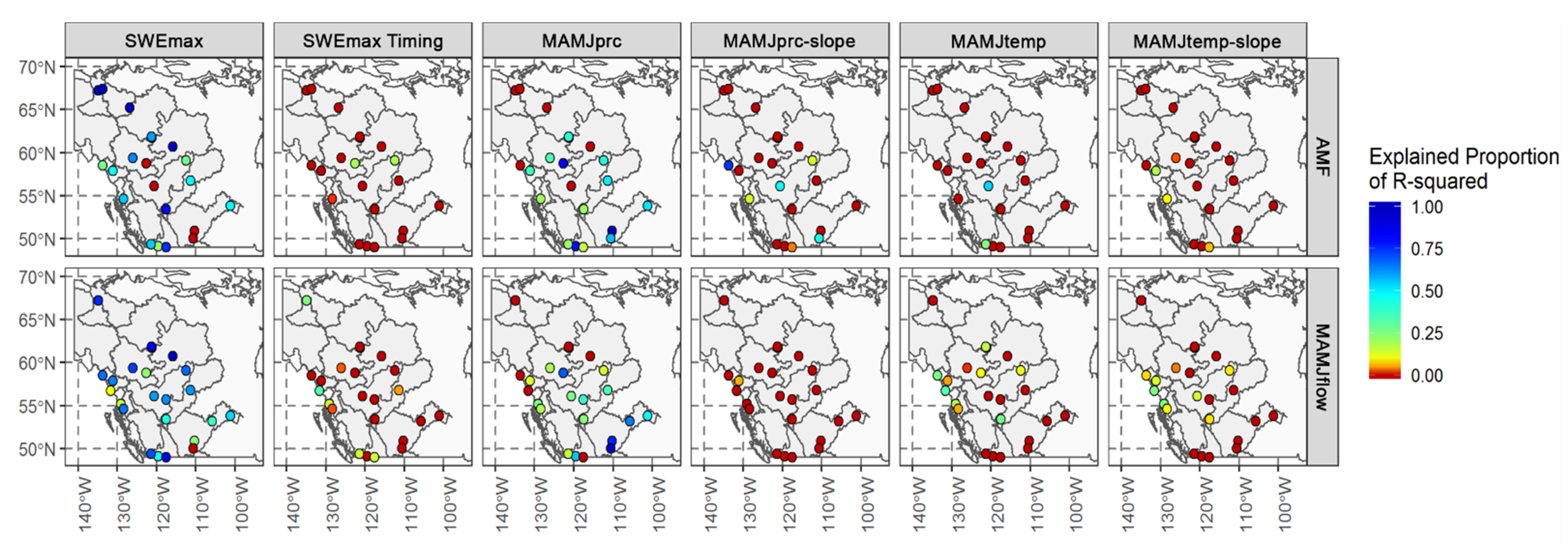
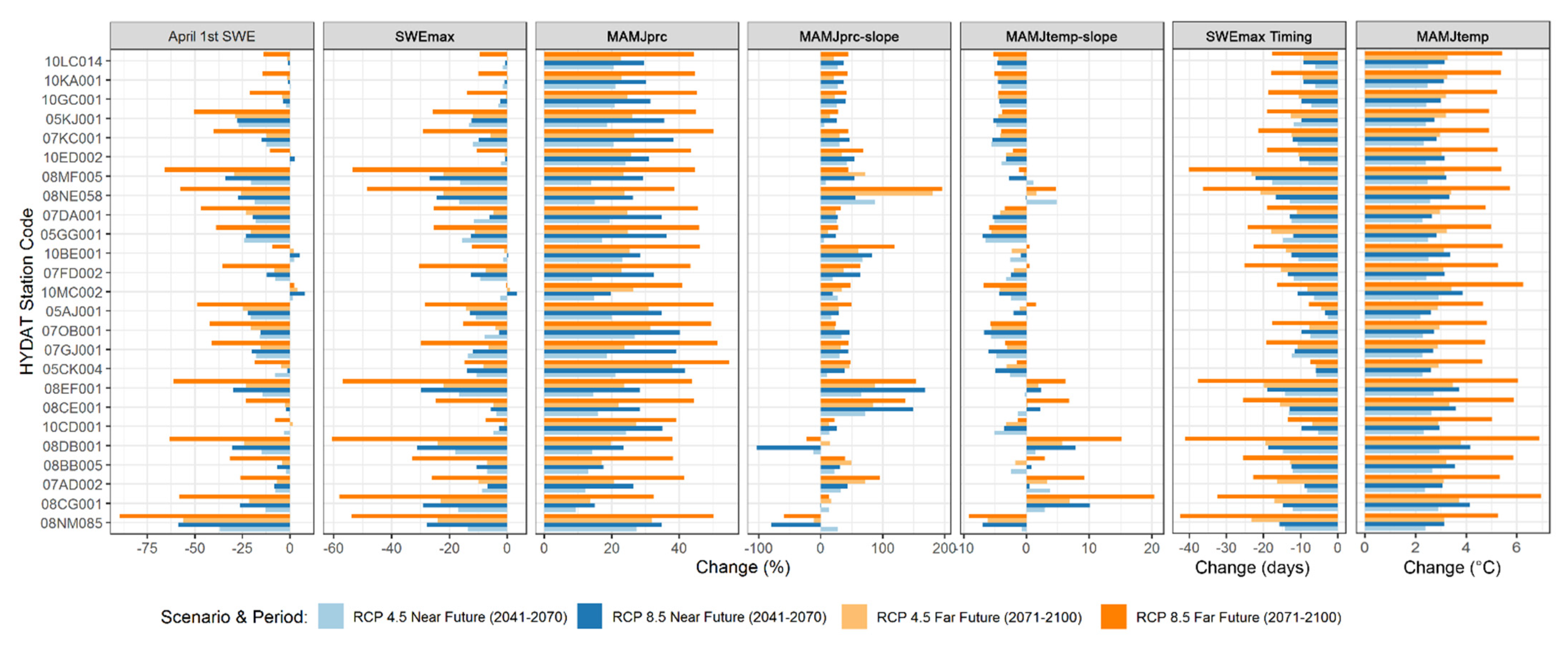
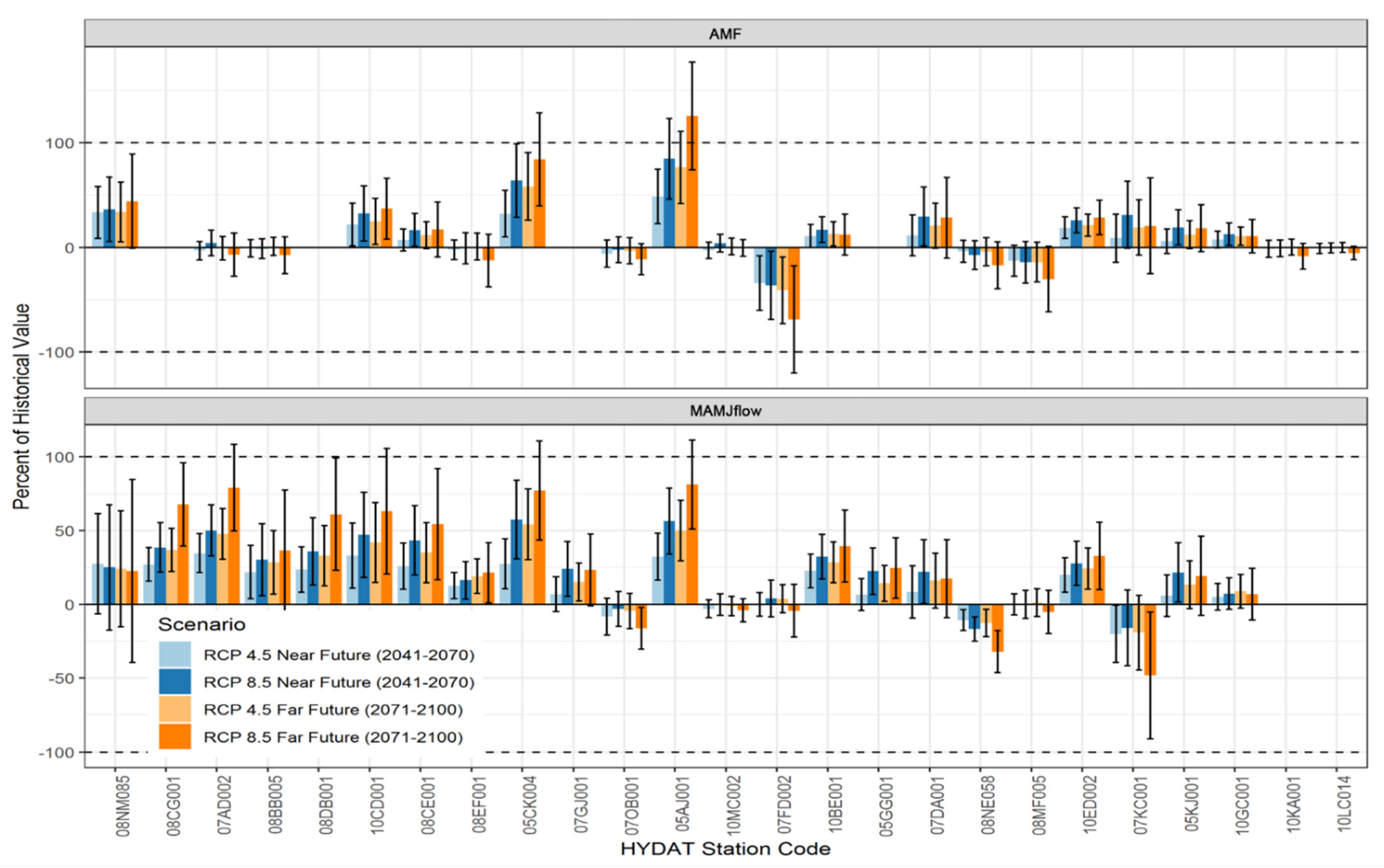
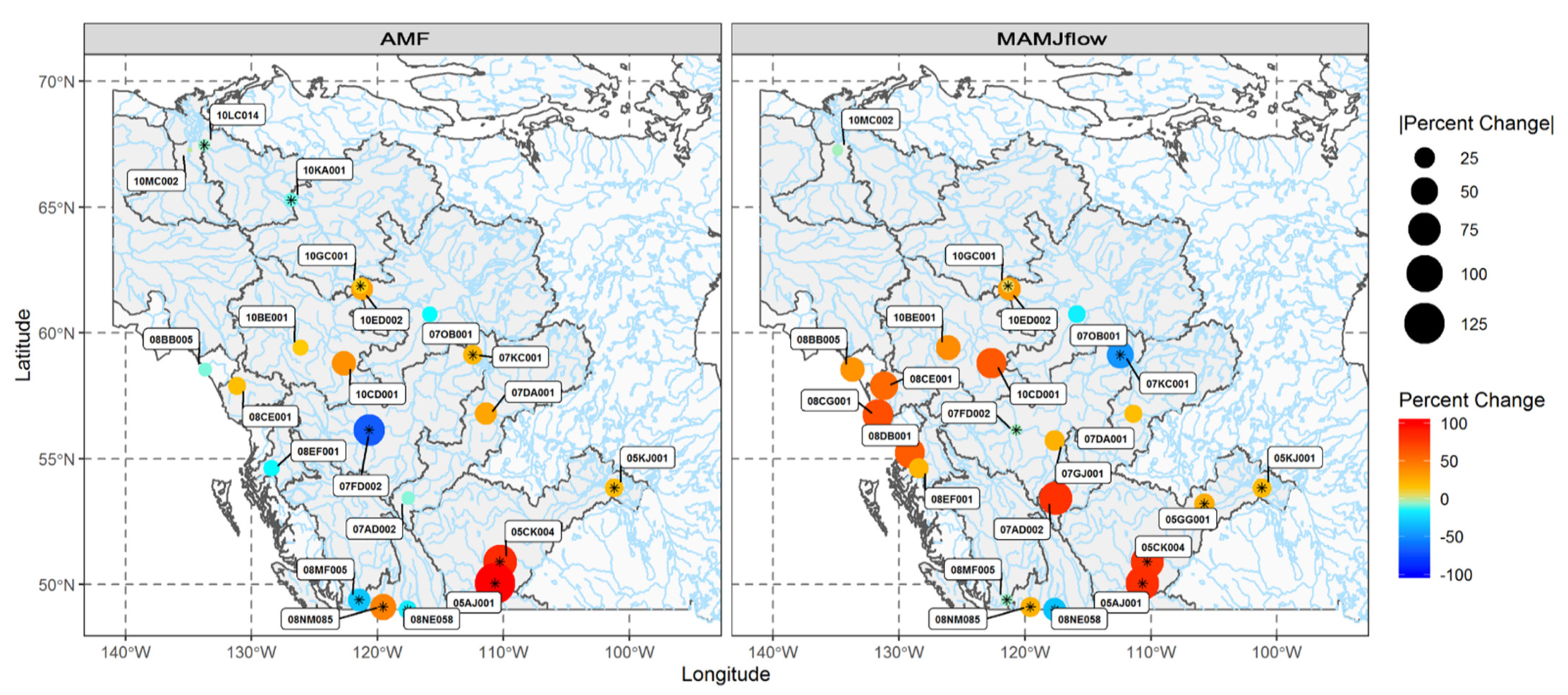
| Number | Station Name | Area (km2) | Lat | Lon | Regulation |
|---|---|---|---|---|---|
| 10LC014 | Mackenzie River at Arctic Red River | 1,680,000 | 67.4560 | −133.7533 | Yes |
| 10KA001 | Mackenzie River at Norman Wells | 1,590,000 | 65.2720 | −126.8500 | Yes |
| 10GC001 | Mackenzie River at Fort Simpson | 1,300,000 | 61.8684 | −121.3589 | Yes |
| 05KJ001 | Saskatchewan River at the Pas | 389,000 | 53.8381 | −101.2087 | Yes |
| 07KC001 | Peace River at Peace Point | 293,000 | 59.1181 | −112.4369 | Yes |
| 10ED002 | Liard River near the Mouth | 275,000 | 61.7427 | −121.2280 | No |
| 08MF005 | Fraser River at Hope | 217,000 | 49.3860 | −121.4542 | Yes |
| 08NE058 | Columbia River at International Boundary | 156,000 | 49.0008 | −117.6283 | Yes |
| 07DA001 | Athabasca River below Fort McMurray | 133,000 | 56.7804 | −111.4022 | No |
| 05GG001 | North Saskatchewan River at Prince Albert | 131,000 | 53.2034 | −105.7721 | Yes |
| 10BE001 | Liard River at lower Crossing | 104,000 | 59.4125 | −126.0972 | No |
| 07FD002 | Peace River near Taylor | 101,000 | 56.1394 | −120.6724 | Yes |
| 10MC002 | Peel River above Fort McPherson | 70,600 | 67.2589 | −134.8888 | No |
| 05AJ001 | South Saskatchewan River at Medicine Hat | 56,368 | 50.0421 | −110.6775 | Yes |
| 07OB001 | Hay River near Hay River | 51,700 | 60.7430 | −115.8596 | No |
| 07GJ001 | Smoky River at Watino | 50,300 | 55.7146 | −117.6231 | No |
| 05CK004 | Red Deer River near Bindloss | 47,849 | 50.9027 | −110.2995 | Yes |
| 08EF001 | Skeena River at Usk | 42,300 | 54.6319 | −128.4306 | No |
| 08CE001 | Stikine River at Telegraph Creek | 29,000 | 57.9003 | −131.1597 | No |
| 10CD001 | Muskwa River near Fort Nelson | 20,300 | 58.7881 | −122.6616 | No |
| 08DB001 | Nass River above Shumal Creek | 18,400 | 55.2623 | −129.0850 | No |
| 08BB005 | Taku River near Juneau | 16,700 | 58.5386 | −133.7000 | No |
| 07AD002 | Athabasca River at Hinton | 9760 | 53.4243 | −117.5694 | No |
| 08CG001 | Iskut River below Johnson River | 9500 | 56.7344 | −131.6690 | No |
| 08NM085 | Okanagan River near Oliver | 7540 | 49.1146 | −119.5667 | Yes |
| Predictor Name | Abbreviation | Units | Data Source |
|---|---|---|---|
| Annual maximum snow water equivalent | SWEmax | MERRA-2 | |
| Date of annual maximum snow water equivalent | SWEmax-date | Date number | MERRA-2 |
| April 1st snow water equivalent | SWEapril 1st | MERRA-2 | |
| Average spring temperature | MAMJtemp | PNWNAmet | |
| Rate of change in spring temperature | MAMJtemp-slope | PNWNAmet | |
| Total spring precipitation | MAMJpcp | PNWNAmet | |
| Rate of change in spring precipitation | MAMJpcp-slope | PNWNAmet |
Publisher’s Note: MDPI stays neutral with regard to jurisdictional claims in published maps and institutional affiliations. |
© 2021 by the authors. Licensee MDPI, Basel, Switzerland. This article is an open access article distributed under the terms and conditions of the Creative Commons Attribution (CC BY) license (https://creativecommons.org/licenses/by/4.0/).
Share and Cite
Dibike, Y.B.; Shrestha, R.R.; Johnson, C.; Bonsal, B.; Coulibaly, P. Assessing Climatic Drivers of Spring Mean and Annual Maximum Flows in Western Canadian River Basins. Water 2021, 13, 1617. https://doi.org/10.3390/w13121617
Dibike YB, Shrestha RR, Johnson C, Bonsal B, Coulibaly P. Assessing Climatic Drivers of Spring Mean and Annual Maximum Flows in Western Canadian River Basins. Water. 2021; 13(12):1617. https://doi.org/10.3390/w13121617
Chicago/Turabian StyleDibike, Yonas B., Rajesh R. Shrestha, Colin Johnson, Barrie Bonsal, and Paulin Coulibaly. 2021. "Assessing Climatic Drivers of Spring Mean and Annual Maximum Flows in Western Canadian River Basins" Water 13, no. 12: 1617. https://doi.org/10.3390/w13121617
APA StyleDibike, Y. B., Shrestha, R. R., Johnson, C., Bonsal, B., & Coulibaly, P. (2021). Assessing Climatic Drivers of Spring Mean and Annual Maximum Flows in Western Canadian River Basins. Water, 13(12), 1617. https://doi.org/10.3390/w13121617









